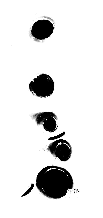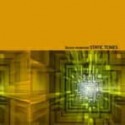
cajid 002cd
STATIC TONES
bruce mowson
An intricate, yet unchanging mass of sound comprised of tiny repeating fragments. Although unchanging, the static tones create an illusion of movement and change, with perceptual distortions generated by the listener.
“The psychoacoustic effect of the music was like a mirage, with details of the sounds emerging and receding even though there were in fact no changes in it at all. A worthy successor to Jim Tenney’s For Ann (Rising)." Ed Osborn -
Bruce Mowson’s "Static Tones" project explores perception through static or near static time-
LISTEN
track 3 (excerpt)
mp3 1:04min 757k
ARTIST STATEMENT
The psycho-
That said, the sounds have been partly selected for the way that they tend to work with the acoustics of a room, creating a phenomenon though which you hear different details of the mix as you move your head. With limiting the scope of the music in so many ways, it's nice to be generous with this spatial, or physical, dimension.
For me, in life, it is difficult to stop and identify exactly what is... is it me, my environment... how can I change the past/present/future... is it my attitude, or my actions? The space of these notions and feelings, about being and the passing of time, hopefully find their way into Static Tones...
REVIEWS
Also look at label profile: OFF THE SPINE – cajid media in e|i magazine issue 8, which looks at our first 5 releases
Paris Transatlantic Feb 2005
Walt Miller
"Headphones not permitted" it says on the record. Don't you fuckin' tell me what not to do, matey! If I want to listen to Merzbow at bernhard günter volume or vice versa (choose Scumtron and you can have both at the same time!) that's my business! Actually, the Cajid Media press release is a little more diplomatic: "headphones not recommended." Anyway, they've got a point. On a set of cans this stuff would be completely without interest, as listener participation (i.e. a slight move of the head left or right, or up and down, or a brief trip to the smallest room to vomit if you play it loud enough) is what Mowson's three pieces are all about. Not exactly a new idea (try it out with any sustained unchanging music and you'll find it works – particularly recommended are La Monte Young, Phill Niblock, David First and Sachiko M, of course) but always good for a few minutes' worth of fun. The first track lasts 12'30" but the music (I'm not sure that's the right for this stuff, but we'll stick with it) stops at 9'00". Similarly track two (total duration 13'05") falls silent, though not for long, after 9'36", and in track three your head stops spinning before the album itself does. Great review, eh? Well, there's not much else to say. If this is the kind of acoustic research that you like to indulge in, this is right up your alley. Here in my smallish living room I can't really push the volume high enough to get the thrill of it all, relations with neighbours being tense enough as it is. I rather fancy I'd enjoy it more in a gallery installation context. But the choice is up to you.—DW
Splendid ezine Dec 12 2004
Melbourne-
Released on the Aussie experimental label Cajid, Static Tones, pushes the concepts of minimalism to the edge of the envelope. You can either roll your eyes at the singular vision behind it all (one that brings new meaning to the phrase "beating a dead horse") or you can lose yourself in the grand cacophony of unadulterated trance music. Whether you buy into Mowson's point of view or not, it at least serves as a provocative reminder: music swirls around and through the air, no matter where we are, even when we aren't paying attention.
Cyclic Defrost Issue #9 (October 2004)
Static Tones is an apt title for this work by Melbourne sound artist Bruce Mowson, perhaps best known as the co director of the Liquid Architecture Sound Art Festival. Generating an unchanging mass of sound imbued with an internal repetitive rhythm, Mowson has produced three twelve and a half minute plus tracks that though they are in reality as the title suggests static, appear to be constantly though quite subtly changing. This is a project that actively invites your ears play tricks upon you, which they inevitably do when faced with such an unmoveable slab of sound. If you are actively listening, in order to make sense of what you are hearing it seems your ears are drawn to highlight particular aspects of the sounds, allowing the listener to break up the piece and have revealed for the first time previously hidden internal sounds and cadences. Though it’s not noise music as such, Mowson is working with thick deep tones that can become quite intense at high volumes. What may be more disquieting however is the concept behind the work, and the unshakeable feeling that all listeners are somehow just guinea pigs in Mowson’s sonic experiments. -
Phosphor Magazine
After an excellent CD by Thembi Soddell, Cajid Media's second release presents another Melbourne sound artist called Bruce Mowson. He is the co-
&_notes 10 (ampersand)
A new release from cajid media (www.cajid.com ? based in Bendigo): Bruce Mawson?s Static Tones. This is three longish pieces (around 12 minutes but not all is sound) based on Œtiny repeating fragments? which are repeateddensely and minimalistically in an unchanging seeming sound flow during the length of the track. A quick look at a wave output does show a pretty consistent form. The result is like being inside a throbbing machine ? the tracks are different in their constructs but similar in their construction. As you listen, moving around (headphones are Œnot permitted?) different interactions occur (similar to some of Ikeda?s music) providing an at-
vital weekly
This is the first time I hear of Bruce Mowson, who is a sound artist from Melbourne and co-
reviews of static tones performances
"Bruce Mowson’s work of stark minimalism contrasted forcefully with Priest’s complex multilayering. The affable Mowson presented his piece with a short contextualisation of the piece’s provenance in his Static Tones project–his aim is to produce the most minimal, pared-
"As the sounds bore on, distinct sounds emerged from the mix; the frenzied thumping of a power turbine, the crackling of electricity, the humming of conductors. The initial snarl of industrial noise gradually disaggregated as the listener became aware of distinct elements in the mix and their interrelation. Ears attuned to the slightest changes in the hammering, buzzing, metallic drone–the piece became a rebus, inviting constant exploration and reconsideration. As with the experience of viewing certain kinds of optical art, the brain refreshes every few seconds, seeking new patterns or ways of understanding, and the constant internal dialogue produced by the questioning of experience was a uniquely and intellectually stimulating. A few heated arguments erupted at the bar at intermission as to whether the sound actually did change at all. Regardless, the highly specific construction and execution (the whole effect is rather like colour-
"Bruce Mowson’s severe approach to composition, 12 minutes of complex and unchanging drones, was the surprise of the evening. The psychoacoustic effect of the music was like a mirage, with details of the sounds emerging and receding even though there were in fact no changes in it at all. A worthy successor to Jim Tenney’s "For Ann (Rising)," I look forward to hearing more." Ed Osborn, Stretcher Archives, August 2003
The festival overall, however, was notable for its diversity. Bruce Mowson for example has a technologically-

